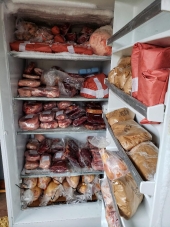
 8
8




 7
7




 4
4




Made a few interesting observations as a beginner gardener last year.
1) The first frost date came about 1 month late here in Oklahoma. Instead of Nov 3 it was Nov 30. (Climate chnage?)
2) I just made guacamole this morning on January 19 2021, with cilantro that was planted back in the summer. Wow it sure is winter hearty! It tastes good too not bitter.
3)All my kale plants are thriving even after many days over winter in the 20's (F). What would happen if I just let them stay there, would they be good for another year? Or do I need to pull them at some point and plant new seed?
Thanks, Y'all!
 2
2




 Leaves aren't full of holes! Which is nice. I have enough plants to pick here and there and it'll probably grow fast enough for me through the winter. I have like 6 different plants of varying variety. Time to start cooking some dishes with kale in it. I like to mince a bunch , throw in a little minced onion, and fry it up a bit in butter and salt.. then mix in some scrambled eggs and make a fritatta, topped with cheese.
Leaves aren't full of holes! Which is nice. I have enough plants to pick here and there and it'll probably grow fast enough for me through the winter. I have like 6 different plants of varying variety. Time to start cooking some dishes with kale in it. I like to mince a bunch , throw in a little minced onion, and fry it up a bit in butter and salt.. then mix in some scrambled eggs and make a fritatta, topped with cheese. 2
2




 2
2




 1
1




 2
2





 3
3




 2
2




![Filename: IMG_7164.jpeg
Description: [Thumbnail for IMG_7164.jpeg]](/t/154577/a/133612/IMG_7164.jpeg)
 2
2




“We can complain because rose bushes have thorns, or rejoice because thorn bushes have roses.” — Abraham Lincoln
 2
2




![Filename: IMG_7310.jpeg
Description: [Thumbnail for IMG_7310.jpeg]](/t/154577/a/134533/IMG_7310.jpeg)
![Filename: IMG_7311.jpeg
Description: [Thumbnail for IMG_7311.jpeg]](/t/154577/a/134534/IMG_7311.jpeg)
![Filename: IMG_7312.jpeg
Description: [Thumbnail for IMG_7312.jpeg]](/t/154577/a/134535/IMG_7312.jpeg)
![Filename: IMG_7313.jpeg
Description: [Thumbnail for IMG_7313.jpeg]](/t/154577/a/134536/IMG_7313.jpeg)
 2
2




I am only one, but still I am one. I cannot do everything, but still I can do something; and because I cannot do everything, I will not refuse to do something that I can do. (E.E.Hale)
 1
1




 Survived all winter.. 10 days under ice and snow in -7F weather.
Survived all winter.. 10 days under ice and snow in -7F weather.




 3
3




Pecan Media: food forestry and forest garden ebooks
Now available: The Native Persimmon (centennial edition)




Dan Boone wrote:Jennifer I am delighted that you had kales survive that amazing cold snap. Here in central Oklahoma we got down to -13F and it looks like my old kale plants that sailed through up to three previous winters may indeed be dead as heck. Chives are fine but they used to survive -70F temps when I lived in Alaska, so I expected that. I had some supermarket green onions that were four feet tall (two or more years old) that appear to have been frozen to a useless pulp. Some robust parsley plants I had got utterly destroyed by the -13F, but I expected that. I've had really good luck most years with all kinds of winter greens, but we didn't get any snow until about ten hours before the temps dropped below zero, and we never got more than a couple of inches. I think a foot of snow on top as a blanket would saved more of my typically winter-hardy greens.
 3
3




Jennifer Lowery wrote:
Dang two year old green onions :) I wonder what they taste like after 2 years in the ground -- living of course.
Jennifer Lowery wrote:So the same kale plants survived for several years outside wow. Did they produce flowers for you the 2nd spring? If so about when? As long as I keep the bolts trimmed, how does the kale taste? Is it bitter like other plants? Just wondering if I even need to plant these new kale seedlings (six varieties) which are growin' inside right now :) Would lettuce survive the winter here in Oklhaoma normally without a cold frame? Just wondering if I really need to both building a cold frame.
Pecan Media: food forestry and forest garden ebooks
Now available: The Native Persimmon (centennial edition)
 1
1




 1
1








 1
1




Jennifer Lowery wrote:I was just admiring how beautiful the kale plants are looking after a couple weeks of sun, (after surviving -7F weather) ... growing fast.. nice big leaves. How big and beautiful they get when there are no white moths flying about them laying eggs. It was this morning I last admired them.
Guess what, I just looked out the window and see 3 white moths all over them, landing on the leaves doing their nasty business. I guess they admire them too.. SIGH.
I don't know what to do.. I know if a few weeks the leaves will be full of holes.
Should I spray thuricide on them once a week?





Works at a residential alternative high school in the Himalayas SECMOL.org . "Back home" is Cape Cod, E Coast USA.








“We can complain because rose bushes have thorns, or rejoice because thorn bushes have roses.” — Abraham Lincoln




Permies is awesome!!!

|
Heroic work plunger man. Please allow me to introduce you to this tiny ad:
Willow Feeder movie
https://permies.com/t/273181/Willow-Feeder-movie
|





